tire type INFINITI Q60 COUPE 2014 Towing Guide
[x] Cancel search | Manufacturer: INFINITI, Model Year: 2014, Model line: Q60 COUPE, Model: INFINITI Q60 COUPE 2014Pages: 25, PDF Size: 0.88 MB
Page 2 of 25
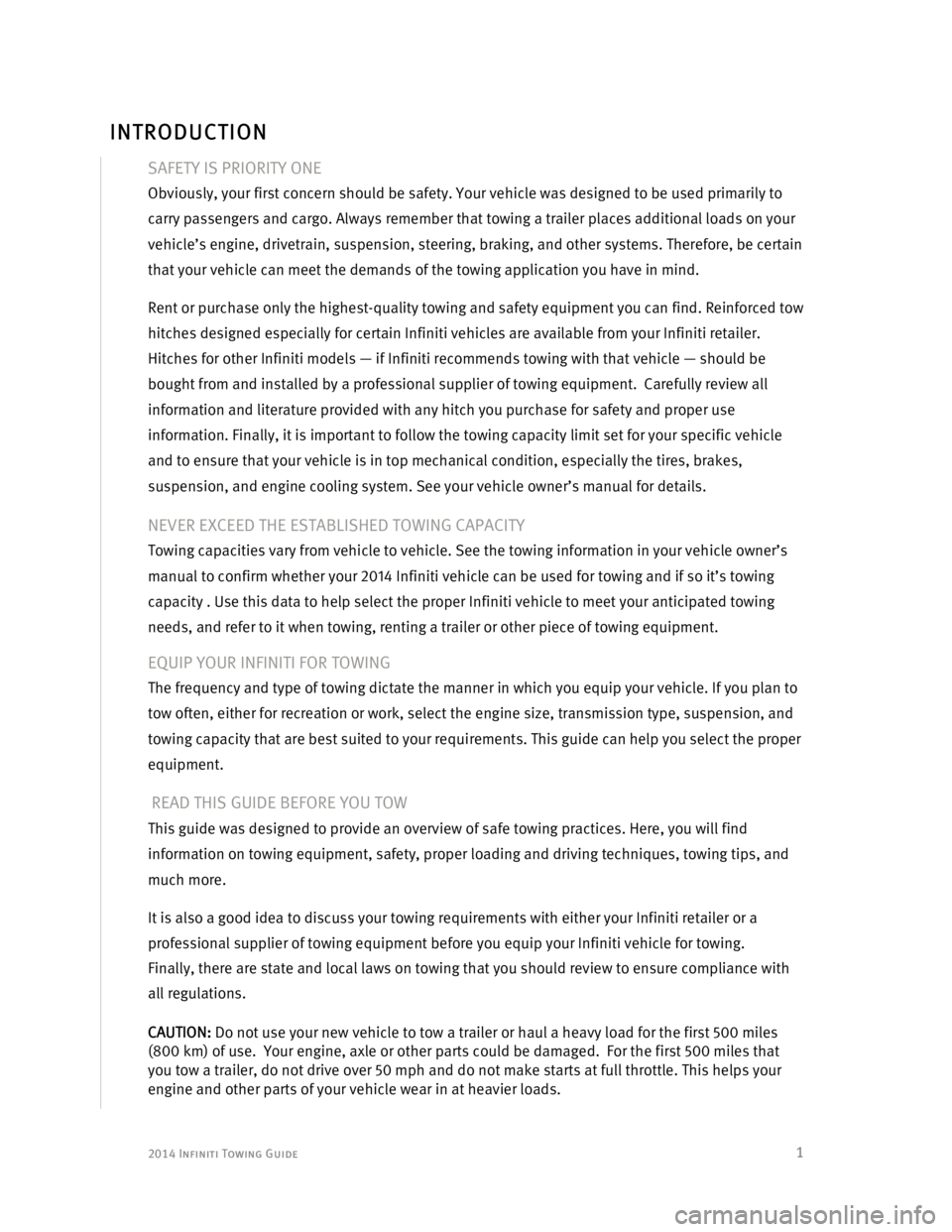
2014 Infiniti Towing Guide
1
SAFETY IS PRIORITY ONE
Obviously, your first concern should be safety. Your vehicle was designed to be used primarily to
carry passengers and cargo. Always remember that towing a trailer places additional loads on your
vehicle’s engine, drivetrain, suspension, steering, braking, and other systems. Therefore, be certain
that your vehicle can meet the demands of the towing application you have in mind.
Rent or purchase only the highest-quality towing and safety equipment you can find. Reinforced tow
hitches designed especially for certain Infiniti vehicles are available from your Infiniti retailer.
Hitches for other Infiniti models — if Infiniti recommends towing with that vehicle — should be
bought from and installed by a professional supplier of towing equipment. Carefully review all
information and literature provided with any hitch you purchase for safety and proper use
information. Finally, it is important to follow the towing capacity limit set for your specific vehicle
and to ensure that your vehicle is in top mechanical condition, especially the tires, brakes,
suspension, and engine cooling system. See your vehicle owner’s manual for details.
NEVER EXCEED THE ESTABLISHED TOWING CAPACITY
Towing capacities vary from vehicle to vehicle. See the towing information in your vehicle owner’s
manual to confirm whether your 2014 Infiniti vehicle can be used for towing and if so it’s towing
capacity . Use this data to help select the proper Infiniti vehicle to meet your anticipated towing
needs, and refer to it when towing, renting a trailer or other piece of towing equipment.
EQUIP YOUR INFINITI FOR TOWING
The frequency and type of towing dictate the manner in which you equip your vehicle. If you plan to
tow often, either for recreation or work, select the engine size, transmission type, suspension, and
towing capacity that are best suited to your requirements. This guide can help you select the proper
equipment.
READ THIS GUIDE BEFORE YOU TOW
This guide was designed to provide an overview of safe towing practices. Here, you will find
information on towing equipment, safety, proper loading and driving techniques, towing tips, and
much more.
It is also a good idea to discuss your towing requirements with either your Infiniti retailer or a
professional supplier of towing equipment before you equip your Infiniti vehicle for towing.
Finally, there are state and local laws on towing that you should review to ensure compliance with
all regulations.
CAUTION: Do not use your new vehicle to tow a trailer or haul a heavy load for the first 500 miles
(800 km) of use. Your engine, axle or other parts could be damaged. For the first 500 miles that
you tow a trailer, do not drive over 50 mph and do not make starts at full throttle. This helps your
engine and other parts of your vehicle wear in at heavier loads.
INTRODUCTION
Page 3 of 25
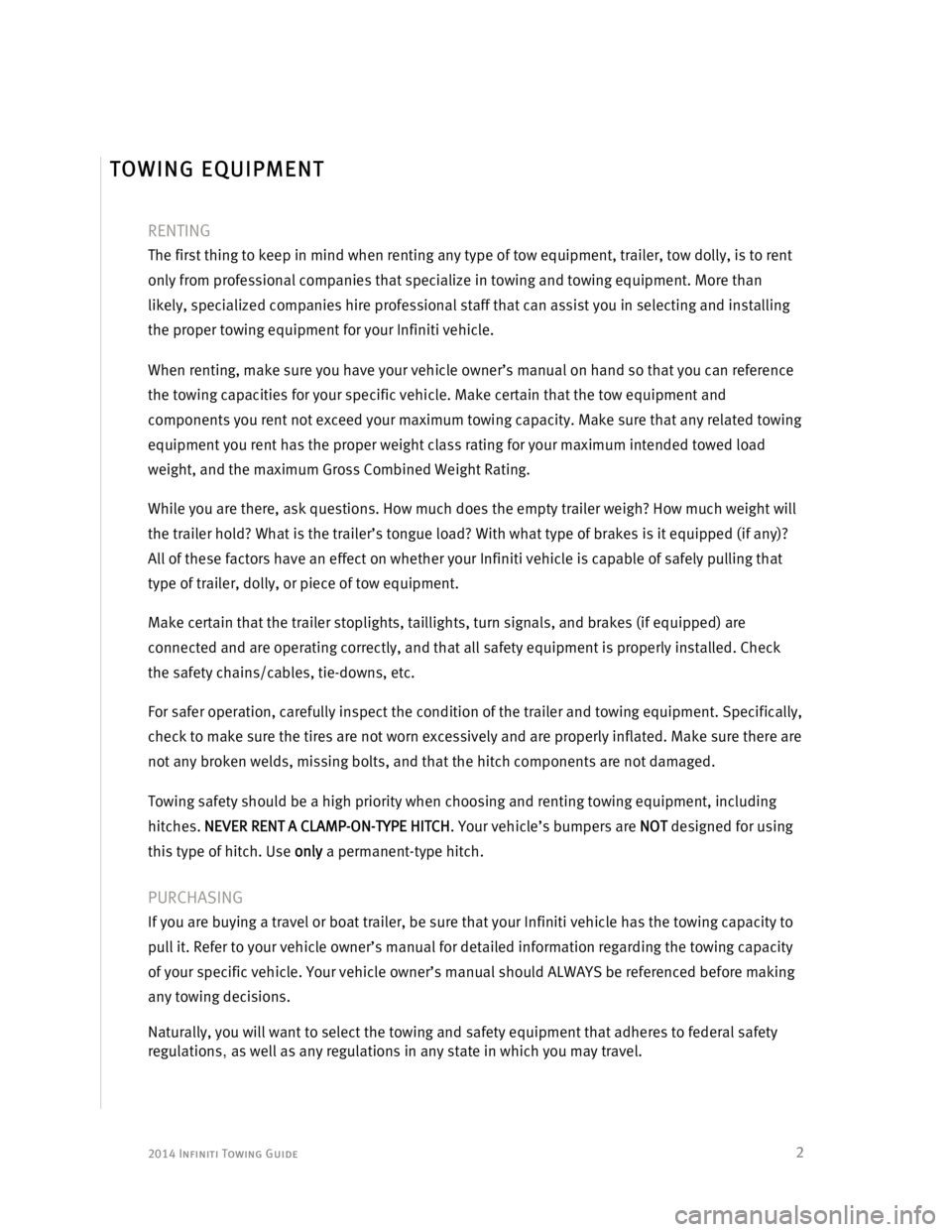
2014 Infiniti Towing Guide
2
RENTING
The first thing to keep in mind when renting any type of tow equipment, trailer, tow dolly, is to rent
only from professional companies that specialize in towing and towing equipment. More than
likely, specialized companies hire professional staff that can assist you in selecting and installing
the proper towing equipment for your Infiniti vehicle.
When renting, make sure you have your vehicle owner’s manual on hand so that you can reference
the towing capacities for your specific vehicle. Make certain that the tow equipment and
components you rent not exceed your maximum towing capacity. Make sure that any related towing
equipment you rent has the proper weight class rating for your maximum intended towed load
weight, and the maximum Gross Combined Weight Rating.
While you are there, ask questions. How much does the empty trailer weigh? How much weight will
the trailer hold? What is the trailer’s tongue load? With what type of brakes is it equipped (if any)?
All of these factors have an effect on whether your Infiniti vehicle is capable of safely pulling that
type of trailer, dolly, or piece of tow equipment.
Make certain that the trailer stoplights, taillights, turn signals, and brakes (if equipped) are
connected and are operating correctly, and that all safety equipment is properly installed. Check
the safety chains/cables, tie-downs, etc.
For safer operation, carefully inspect the condition of the trailer and towing equipment. Specifically,
check to make sure the tires are not worn excessively and are properly inflated. Make sure there are
not any broken welds, missing bolts, and that the hitch components are not damaged.
Towing safety should be a high priority when choosing and renting towing equipment, including
hitches. NEVER RENT A CLAMP-ON-TYPE HITCH. Your vehicle’s bumpers are NOT designed for using
this type of hitch. Use only a permanent-type hitch.
PURCHASING
If you are buying a travel or boat trailer, be sure that your Infiniti vehicle has the towing capacity to
pull it. Refer to your vehicle owner’s manual for detailed information regarding the towing capacity
of your specific vehicle. Your vehicle owner’s manual should ALWAYS be referenced before making
any towing decisions.
Naturally, you will want to select the towing and safety equipment that adheres to federal safety
regulations, as well as any regulations in any state in which you may travel.
TOWING EQUIPMENT
Page 4 of 25
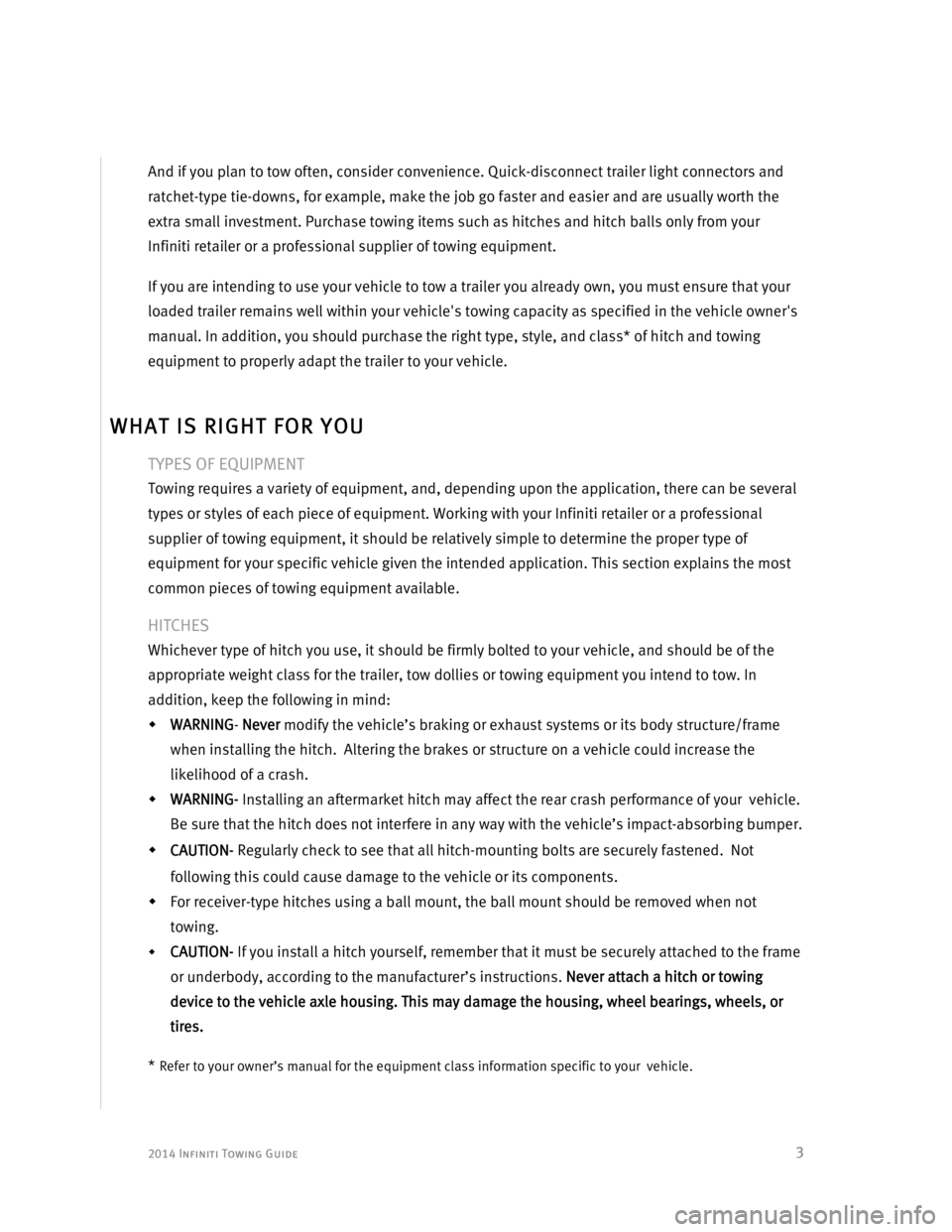
2014 Infiniti Towing Guide
3
And if you plan to tow often, consider convenience. Quick-disconnect trailer light connectors and
ratchet-type tie-downs, for example, make the job go faster and easier and are usually worth the
extra small investment. Purchase towing items such as hitches and hitch balls only from your
Infiniti retailer or a professional supplier of towing equipment.
If you are intending to use your vehicle to tow a trailer you already own, you must ensure that your
loaded trailer remains well within your vehicle's towing capacity as specified in the vehicle owner's
manual. In addition, you should purchase the right type, style, and class* of hitch and towing
equipment to properly adapt the trailer to your vehicle.
TYPES OF EQUIPMENT
Towing requires a variety of equipment, and, depending upon the application, there can be several
types or styles of each piece of equipment. Working with your Infiniti retailer or a professional
supplier of towing equipment, it should be relatively simple to determine the proper type of
equipment for your specific vehicle given the intended application. This section explains the most
common pieces of towing equipment available.
HITCHES
Whichever type of hitch you use, it should be firmly bolted to your vehicle, and should be of the
appropriate weight class for the trailer, tow dollies or towing equipment you intend to tow. In
addition, keep the following in mind:
�Š WARNING- Never modify the vehicle’s braking or exhaust systems or its body structure/frame
when installing the hitch. Altering the brakes or structure on a vehicle could increase the
likelihood of a crash.
�Š WARNING- Installing an aftermarket hitch may affect the rear crash performance of your vehicle.
Be sure that the hitch does not interfere in any way with the vehicle’s impact-absorbing bumper.
�Š CAUTION- Regularly check to see that all hitch-mounting bolts are securely fastened. Not
following this could cause damage to the vehicle or its components.
�Š For receiver-type hitches using a ball mount, the ball mount should be removed when not
towing.
�Š CAUTION- If you install a hitch yourself, remember that it must be securely attached to the frame
or underbody, according to the manufacturer’s instructions. Never attach a hitch or towing
device to the vehicle axle housing. This may damage the housing, wheel bearings, wheels, or
tires.
*
Refer to your owner’s manual for the equipment class information specific to your vehicle.
WHAT IS RIGHT FOR YOU
Page 11 of 25
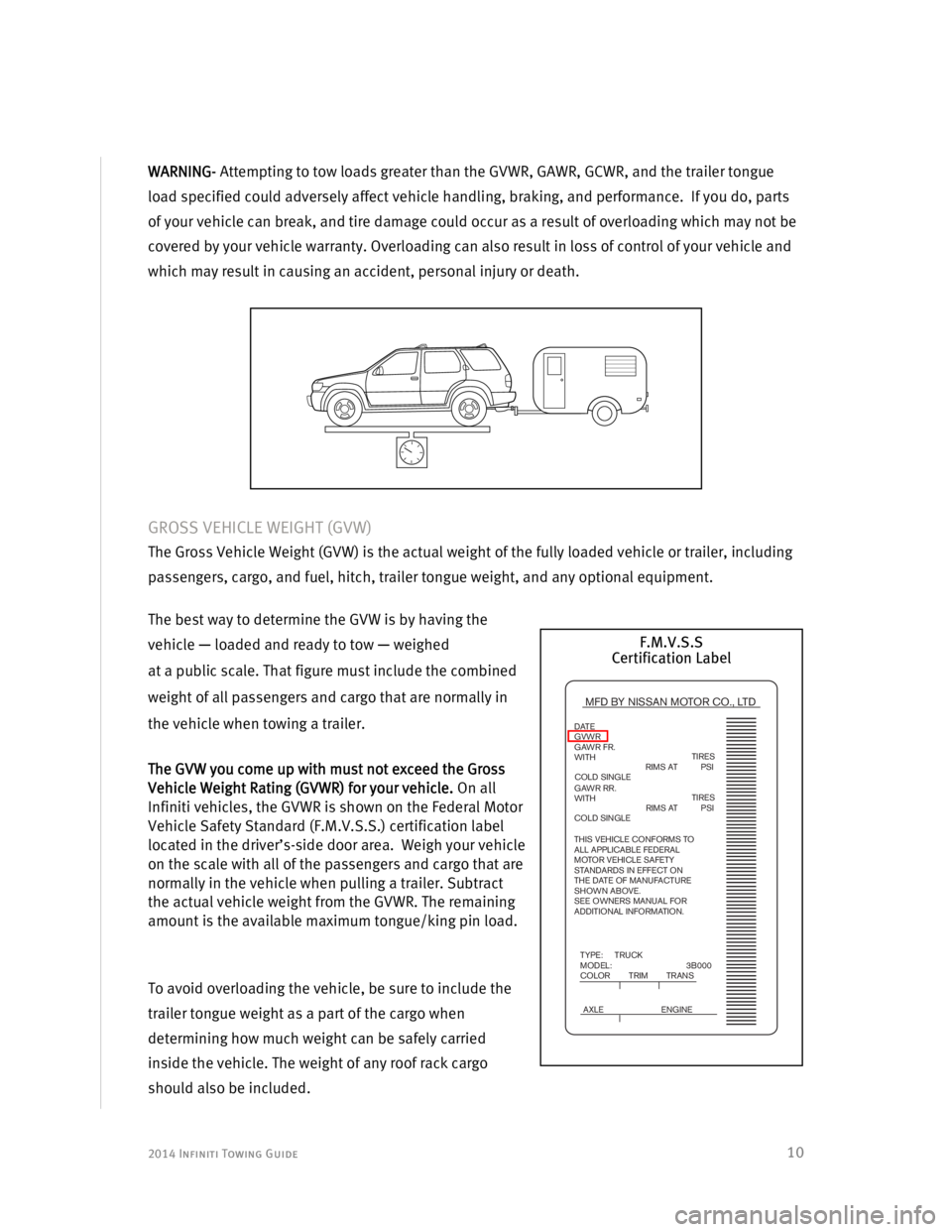
2014 Infiniti Towing Guide
10
WARNING- Attempting to tow loads greater than the GVWR, GAWR, GCWR, and the trailer tongue
load specified could adversely affect vehicle handling, braking, and performance. If you do, parts
of your vehicle can break, and tire damage could occur as a result of overloading which may not be
covered by your vehicle warranty. Overloading can also result in loss of control of your vehicle and
which may result in causing an accident, personal injury or death.
GROSS VEHICLE WEIGHT (GVW)
The Gross Vehicle Weight (GVW) is the actual weight of the fully loaded vehicle or trailer, including
passengers, cargo, and fuel, hitch, trailer tongue weight, and any optional equipment.
The best way to determine the GVW is by having the
vehicle — loaded and ready to tow — weighed
at a public scale. That figure must include the combined
weight of all passengers and cargo that are normally in
the vehicle when towing a trailer.
The GVW you come up with must not exceed the Gross
Vehicle Weight Rating (GVWR) for your vehicle. On all
Infiniti vehicles, the GVWR is shown on the Federal Motor
Vehicle Safety Standard (F.M.V.S.S.) certification label
located in the driver’s-side door area. Weigh your vehicle
on the scale with all of the passengers and cargo that are
normally in the vehicle when pulling a trailer. Subtract
the actual vehicle weight from the GVWR. The remaining
amount is the available maximum tongue/king pin load.
To avoid overloading the vehicle, be sure to include the
trailer tongue weight as a part of the cargo when
determining how much weight can be safely carried
inside the vehicle. The weight of any roof rack cargo
should also be included.
MFD BY NISSAN MOTOR CO., LTD
DATE
GVWR
GAWR FR.
WITH
GAWR RR.
WITH
THIS VEHICLE CONFORMS TO
ALL APPLICABLE FEDERAL
MOTOR VEHICLE SAFETY
STANDARDS IN EFFECT ON
THE DATE OF MANUFACTURE
SHOWN ABOVE.
SEE OWNERS MANUAL FOR
ADDITIONAL INFORMATION.
TIRES
TIRES
TYPE: TRUCK
MODEL: 3B000
COLOR TRIM TRANS
AXLE ENGINE
RIMS AT PSI
COLD SINGLERIMS AT PSI
COLD SINGLE
F.M.V.S.S
Certification Label
Page 22 of 25
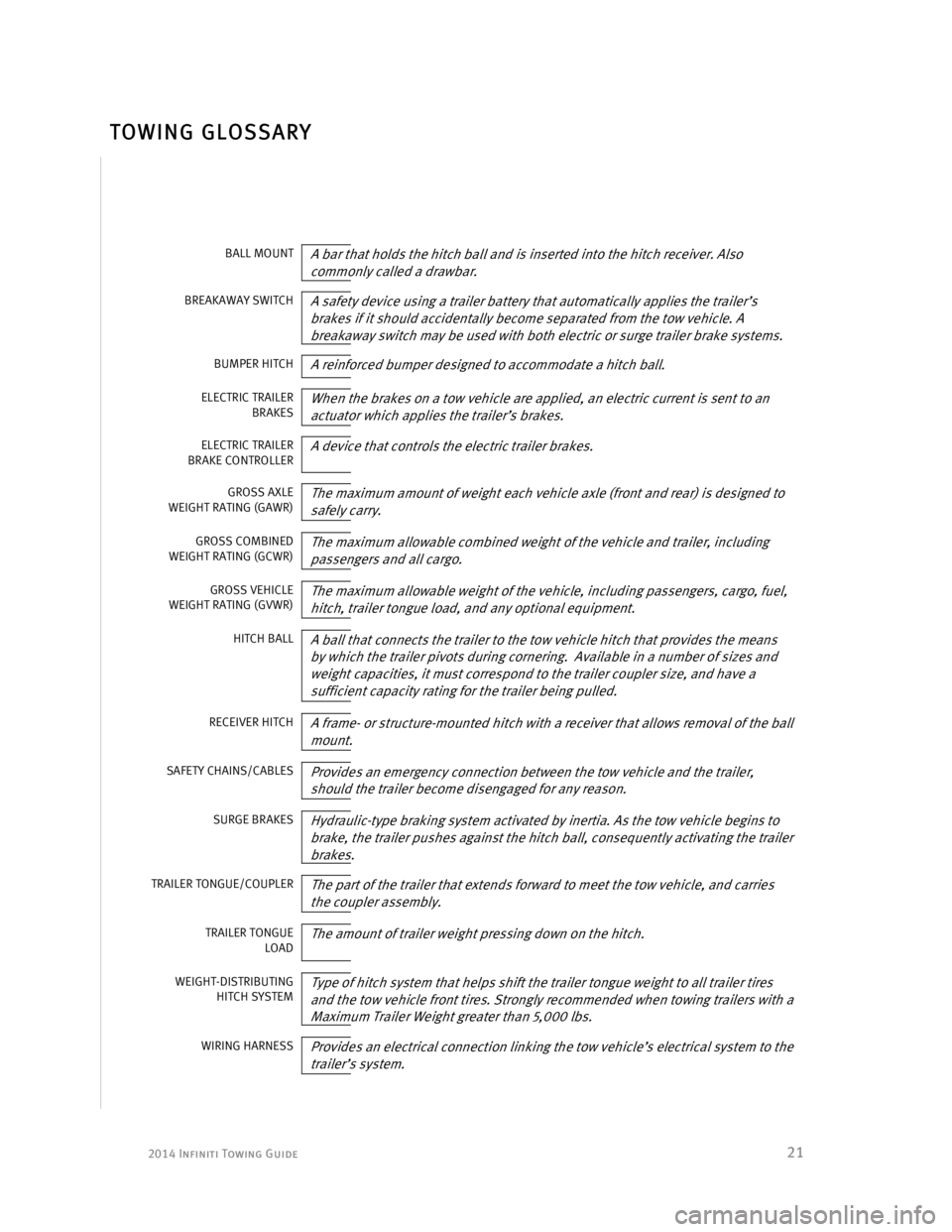
2014 Infiniti Towing Guide
21
BALL MOUNT A bar that holds the hitch ball and is inserted into the hitch receiver. Also
commonly called a drawbar.
BREAKAWAY SWITCH A safety device using a trailer battery that automatically applies the trailer’s
brakes if it should accidentally become separated from the tow vehicle. A
breakaway switch may be used with both electric or surge trailer brake systems.
BUMPER HITCH A reinforced bumper designed to accommodate a hitch ball.
ELECTRIC TRAILER BRAKES When the brakes on a tow vehicle are applied, an electric current is sent to an
actuator which applies the trailer’s brakes.
ELECTRIC TRAILER BRAKE CONTROLLER A device that controls the electric trailer brakes.
GROSS AXLE WEIGHT RATING (GAWR) The maximum amount of weight each vehicle axle (front and rear) is designed to
safely carry.
GROSS COMBINED WEIGHT RATING (GCWR) The maximum allowable combined weight of the vehicle and trailer, including
passengers and all cargo.
GROSS VEHICLE
WEIGHT RATING (GVWR) The maximum allowable weight of the vehicle, including passengers, cargo, fuel,
hitch, trailer tongue load, and any optional equipment.
HITCH BALL
A ball that connects the trailer to the tow vehicle hitch that provides the means
by which the trailer pivots during cornering. Available in a number of sizes and
weight capacities, it must correspond to the trailer coupler size, and have a
sufficient capacity rating for the trailer being pulled.
RECEIVER HITCH A frame- or structure-mounted hitch with a receiver that allows removal of the ball
mount.
SAFETY CHAINS/CABLES Provides an emergency connection between the tow vehicle and the trailer,
should the trailer become disengaged for any reason.
SURGE BRAKES
Hydraulic-type braking system activated by inertia. As the tow vehicle begins to
brake, the trailer pushes against the hitch ball, consequently activating the trailer
brakes.
TRAILER TONGUE/COUPLER The part of the trailer that extends forward to meet the tow vehicle, and carries
the coupler assembly.
TRAILER TONGUE
LOAD The amount of trailer weight pressing down on the hitch.
WEIGHT-DISTRIBUTING
HITCH SYSTEM Type of hitch system that helps shift the trailer tongue weight to all trailer tires
and the tow vehicle front tires. Strongly recommended when towing trailers with a
Maximum Trailer Weight greater than 5,000 lbs.
WIRING HARNESS
Provides an electrical connection linking the tow vehicle’s electrical system to the
trailer’s system.
TOWING GLOSSARY